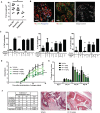Targeting early changes in the synovial microenvironment: a new class of immunomodulatory therapy?
- PMID: 30552174
- PMCID: PMC6352652
- DOI: 10.1136/annrheumdis-2018-214294
Targeting early changes in the synovial microenvironment: a new class of immunomodulatory therapy?
Abstract
Objectives: Controlled immune responses rely on integrated crosstalk between cells and their microenvironment. We investigated whether targeting proinflammatory signals from the extracellular matrix that persist during pathological inflammation provides a viable strategy to treat rheumatoid arthritis (RA).
Methods: Monoclonal antibodies recognising the fibrinogen-like globe (FBG) of tenascin-C were generated by phage display. Clones that neutralised FBG activation of toll-like receptor 4 (TLR4), without impacting pathogenic TLR4 activation, were epitope mapped by crystallography. Antibodies stained synovial biopsies of patients at different stages of RA development. Antibody efficacy in preventing RA synovial cell cytokine release, and in modulating collagen-induced arthritis in rats, was assessed.
Results: Tenascin-C is expressed early in the development of RA, even before disease diagnosis, with higher levels in the joints of people with synovitis who eventually developed RA than in people whose synovitis spontaneously resolved. Anti-FBG antibodies inhibited cytokine release by RA synovial cells and prevented disease progression and tissue destruction during collagen-induced arthritis.
Conclusions: Early changes in the synovial microenvironment contribute to RA progression; blocking proinflammatory signals from the matrix can ameliorate experimental arthritis. These data highlight a new drug class that could offer early, disease-specific immune modulation in RA, without engendering global immune suppression.
Keywords: extracellular matrix; inflammation; monoclonal antibodies; rheumatoid arthritis; tenascin-C.
© Author(s) (or their employer(s)) 2018. Re-use permitted under CC BY. Published by BMJ.
Conflict of interest statement
Competing interests: MRD, PS, KP, AK-V and JLM are employed by IONTAS. EC and PH are employed by Nascient. KSM is a founder and director of Nascient Ltd. AF has received research funding from Roche and Pfizer. KR has received research funding from Abbvie and Pfizer and honoraria/consultancy fees from Lilly, BMS, UCB, Pfizer, Janssen and Roche Chugai. JLM is currently funded by Roche Holding AG. BDM was partly supported by the SGC, which is a registered charity (number 1097737) that receives funds from AbbVie, Bayer Pharma AG, Boehringer Ingelheim, Canada Foundation for Innovation, Eshelman Institute for Innovation, Genome Canada through Ontario Genomics Institute (OGI-055), Innovative Medicines Initiative (EU/EFPIA) (ULTRA-DD grant no. 115766), Janssen, Merck KGaA, Darmstadt, Germany, MSD, Novartis Pharma AG, Ontario Ministry of Research, Innovation and Science (MRIS), Pfizer, Sao Paulo Research Foundation – FAPESP, Takeda and Wellcome (106169/ZZ14/Z).
Figures



Comment in
-
Extracellular matrix in the crosshairs.Nat Rev Rheumatol. 2019 Feb;15(2):65. doi: 10.1038/s41584-019-0160-7. Nat Rev Rheumatol. 2019. PMID: 30617266 No abstract available.
-
Potential roles for tenascin in (very) early diagnosis and treatment of rheumatoid arthritis.Ann Rheum Dis. 2020 Apr;79(4):e42. doi: 10.1136/annrheumdis-2019-215063. Epub 2019 Feb 1. Ann Rheum Dis. 2020. PMID: 30709814 No abstract available.
-
Response to: 'Potential roles for tenascin in (very) early diagnosis and treatment of rheumatoid arthritis' by Cutolo et al.Ann Rheum Dis. 2020 Apr;79(4):e43. doi: 10.1136/annrheumdis-2019-215108. Epub 2019 Feb 12. Ann Rheum Dis. 2020. PMID: 30755416 No abstract available.
References
Publication types
MeSH terms
Substances
Grants and funding
LinkOut - more resources
Full Text Sources
Other Literature Sources
Medical

